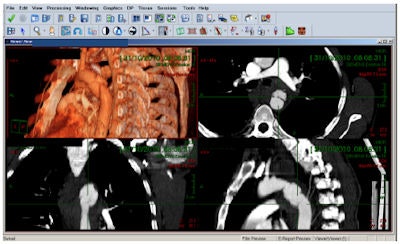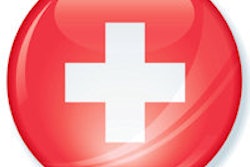
Editor's note: The first part of our profile of the Clalit organization focuses on how PACS is bringing important clinical gains.
Israel's largest health organization, and the second largest worldwide, Clalit, is aiming to lever its recently installed PACS to improve workflow by creating shared worklists for imaging specialists. The move is scheduled to take place when the final three elements of its enterprise-wide PACS are completed, forming the latest string to the bow of one of the most advanced medical information technology systems in the world, explained Dr. Arnon Makori, the organization's director of imaging IT and PACS.
 Dr. Arnon Makori believes that multidomain PACS technology is a "must have" for standard practice in modern medical centers.
Dr. Arnon Makori believes that multidomain PACS technology is a "must have" for standard practice in modern medical centers.
Clalit's radiology unit went digital five years ago, but with image files too large to be sent as emails, the system still relied on CDs for communicating studies.
"This was far from ideal because the patients themselves delivered the CDs to the referring physician. All too often they would forget their CDs, and time would be wasted between appointments," Makori said.
Images would be better enhanced and transmitted by PACS, experts realized, but to meet the needs of a modern health organization, Clalit decided it needed to manage workflow on an enterprise level. This meant managing all medical images from all sites through a comprehensive PACS, not just images generated by radiology departments.
"One of our strategic directions is to improve the integration level among our hospitals and community clinics. Enterprise PACS enables us to achieve this aim," said Dr. Ehud Davidson, head of Clalit's hospital divison.
The superPACS technology would form a bridge between urban and rural medicine, and would be used by imaging specialists together with referring physicians across Clalit's 12 hospitals, 40 imaging centers, and 1,400 clinics throughout Israel.
"Imaging is an integral part of medicine today. By implementing PACS, we truly believe that this can improve the level of care of all people in Israel and Clalit's 4 million insured members, avoiding repetition of studies and providing remote consultation in real-time for complicated services such as oncology, for example," Makori said.
PACS vendor Carestream Health won Clalit's tender to provide PACS, RIS, and cardiology systems. Implementation was scheduled to take three years, but it was completed in October 2010, only 14 months after the installation project began.
"The system is highly user-friendly for both radiologists and nonradiologists, and has immense capabilities for advanced visualization, such as volume rendering, multiplanar reconstruction, and tissue segmentation, embedded in the system and tools for handling large complex imaging datasets," Makori said.

 Using PACS, doctors were able to save the life of a 40-year-old patient following a road traffic accident. CT angiography at Meir Medical Center (level II trauma) demonstrated a contained traumatic rupture of the aorta — a life-threatening condition. Meir emergency room doctors consulted the cardiothoracic unit in Rabin Medical Center (level I trauma) using the PACS. Both groups were able to view in real-time the CT study containing 2,000 images (1,000 MB of imaging data). The advanced visualization tools embedded in the PACS made it possible to complete the diagnosis and surgical planning in minimal time. The images show maximal intensity projection (MIP) and volume rendering (VR) of the ruptured aorta.
Using PACS, doctors were able to save the life of a 40-year-old patient following a road traffic accident. CT angiography at Meir Medical Center (level II trauma) demonstrated a contained traumatic rupture of the aorta — a life-threatening condition. Meir emergency room doctors consulted the cardiothoracic unit in Rabin Medical Center (level I trauma) using the PACS. Both groups were able to view in real-time the CT study containing 2,000 images (1,000 MB of imaging data). The advanced visualization tools embedded in the PACS made it possible to complete the diagnosis and surgical planning in minimal time. The images show maximal intensity projection (MIP) and volume rendering (VR) of the ruptured aorta.Clalit's system needed to incorporate other domains beyond cardiology and endoscopy, even factoring in pathology as a future target domain, according to Makori. Therefore, the PACS had to support multimedia, including JPEGs and movies, in addition to the DICOM standard for images, all of which needed to be seen in a centralized way.
Furthermore, the key algorithms to implement computer-based assistance, such as those used for tissue segmentation, quantitative imaging, substraction, superimposition, computer-aided detection, computer-aided diagnosis, and decision support, can be used by other nonradiologists.
"The idea was to take algorithms developed for these challenges in radiology and make them work for other medical domains," explained Dr. Ziv Rosenbaum, director of medical technology at Clalit Health Services. "It was important to work with a company experienced in setting up radiology PACS because it is easier, faster, and cheaper to widen the scope of existing algorithms rather than invent new algorithms from scratch," he added.
In its final stages of completion is the central disaster recovery site situated 15 km from Clalit's main data center, the hub of all its information communication. The disaster recovery site will, like the main site, benefit from strict data security and dedicated firewalls to protect against hostile attacks, as well as physical on-the-ground security of the premises. It will contain more than ample storage for copies of the 250 TB of imaging data that Clalit generates yearly.
A cardiology PACS module with dedicated tools and functionality for cardiologists also is being implemented, though storage and distribution of cardiology images will, just like other domain images, be conducted through the enterprise-wide superPACS.
Also nearing completion is a new RIS to replace the existing DOS-based legacy RIS. The new system will manage the advanced workflow of electronic requests, scheduling, protocoling, and preauthorization, as well as support tools for voice dictation, the generation of structured reporting, and billing. Incorporating Carestream's Vue Connect product, the system will facilitate the shared organizational worklist within the year.
Just like a call center, all requests for imaging services will be sent to a global worklist, filtered to imaging experts according to their skillset who can undertake tasks on a "first in, first out" basis.
"Having experts pooling the studies, rather than pushing the studies to experts, will improve turnaround time, and fully utilize experts' knowledge," Rosenbaum said.
Click here for part 2 of our profile of Clalit.



















